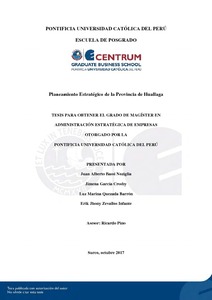| dc.contributor.advisor | Pino Jordán, Ricardo Miguel | |
| dc.contributor.author | Bassi Noziglia, Juan Alberto | es_ES |
| dc.contributor.author | García Crosby, Jimena | es_ES |
| dc.contributor.author | Quezada Barrón, Luz Marina | es_ES |
| dc.contributor.author | Zevallos Infante, Erik Jhony | es_ES |
| dc.date.accessioned | 2017-10-24T16:40:00Z | |
| dc.date.available | 2017-10-24T16:40:00Z | |
| dc.date.created | 2017 | |
| dc.date.issued | 2017-10-24 | |
| dc.identifier.uri | http://hdl.handle.net/20.500.12404/9574 | |
| dc.description.abstract | El plan estratégico para la Provincia de Huallaga tiene como objetivo establecer las
estrategias que le permitan ser reconocida como un referente de desarrollo de una economía
sostenible y de alta relación con la biodiversidad, para lograr, en el largo plazo, ser una
provincia social y económicamente competitiva, donde sus habitantes cuenten con servicios
de agua, saneamiento, comunicaciones, salud y educación de calidad. Para conseguir estos
objetivos se han replanteado actividades como el turismo y la agroindustria, de manera que
sirvan de impulso y contribuyan a mejorar las deficiencias en infraestructura que hoy día se
constituyen en una de las mayores debilidades para el crecimiento de la zona.
Para la elaboración del presente estudio se utilizó el modelo de planeamiento
estratégico diseñado por el profesor Fernando D’Alessio Ipinza. Luego de la evaluación
externa e interna y de acuerdo con la visión de la provincia proyectada al año 2035, se
establecieron 10 Objetivos de Largo Plazo (OLP). Posteriormente, con la elaboración de la
matriz de Fortalezas, Oportunidades, Debilidades y Amenazas (FODA) se generaron 18
estrategias y después de un análisis de las diferentes matrices que plantea la metodología
empleada, se retuvieron 7 estrategias. Asimismo, para alcanzar los OLP se han planteado 46
Objetivos de Corto Plazo (OCP) y 11 políticas que corresponden a cada una de las estrategias
retenidas.
Finalmente, a pesar de la situación actual de la provincia, se considera que existe un
gran potencial de desarrollo, ya que, además de contar con una importante diversidad
biológica, también posee como ventaja comparativa el complejo arqueológico del Gran
Saposoa, el cual se convertirá en la principal ventaja competitiva y en el ingrediente principal
para desarrollar un turismo arqueológico y cultural, que se complementará con el turismo
ecológico impulsando un nuevo clúster de turismo en el norte del país, ampliando la oferta
nacional a diferentes zonas geográficas y culturales | es_ES |
| dc.description.abstract | The aim of the strategic plan for the Huallaga Province is to determine the strategies
that will enable it to be recognized as a development referent of a sustainable economy that is
highly related to biodiversity, in order to become in the long run a socially and economically
competitive province, where the people have all the basic services, including running water,
sewage, good communications, health care and quality education. In order to achieve these
objectives, tourism and agro-industrial activities have been reassessed so as to be used as a
springboard and contribute to the overcoming of the deficiencies in infrastructure that today
constitute one of the main shortcomings for the growth of the area.
To carry out this study, the strategic planning model designed by professor Fernando
D’Alessio Ipinza was used. After doing the external and internal evaluation and according to
the province’s vision projected to the year 2035, ten Long-Term Objectives (LTO) were set
up. Then, after analyzing the Strengths, Weaknesses, Opportunities and Threats (SWOT
matrix), 18 strategies were generated, which were shortlisted to 7 after the application of the
various matrixes proposed by the methodology used. Likewise, in order to achieve the LTOs
46 Short-Term Objectives (STO) were established, as well as 11 policies that correspond to
each of the strategies retained.
Finally, despite the province’s current situation, it was concluded that there is a great
potential for development, since, besides having a significant biological diversity, the Gran
Saposoa archeological site constitutes the main comparative advantage and will become the
main competitive advantage and the major ingredient in the development of archeological
and cultural tourism that will complement the ecological tourism boosting a new tourism
cluster in the north of the country by spreading the national offer to different geographical
and cultural zones | es_ES |
| dc.language.iso | spa | es_ES |
| dc.publisher | Pontificia Universidad Católica del Perú | es_ES |
| dc.rights | info:eu-repo/semantics/openAccess | es_ES |
| dc.rights.uri | http://creativecommons.org/licenses/by-nc-nd/2.5/pe/ | * |
| dc.subject | Planificación regional -- Perú -- San Martín | es_ES |
| dc.subject | Desarrollo regional -- Perú -- San Martín | es_ES |
| dc.subject | Planificación estratégica | es_ES |
| dc.title | Planeamiento estratégico de la Provincia de Huallaga | es_ES |
| dc.type | info:eu-repo/semantics/masterThesis | es_ES |
| thesis.degree.name | Maestro en Administración Estratégica de Empresas | es_ES |
| thesis.degree.level | Maestría | es_ES |
| thesis.degree.grantor | Pontificia Universidad Católica del Perú. CENTRUM | es_ES |
| thesis.degree.discipline | Administración Estratégica de Empresas | es_ES |
| renati.discipline | 413307 | es_ES |
| renati.level | https://purl.org/pe-repo/renati/level#maestro | es_ES |
| renati.type | https://purl.org/pe-repo/renati/type#tesis | es_ES |
| dc.publisher.country | PE | es_ES |
| dc.subject.ocde | https://purl.org/pe-repo/ocde/ford#5.02.04 | es_ES |






